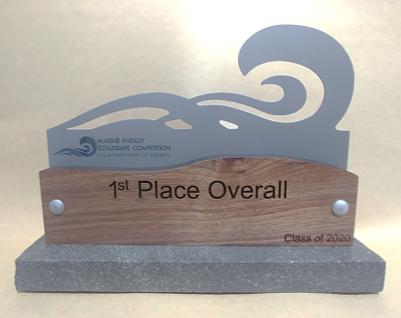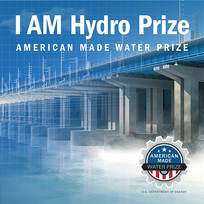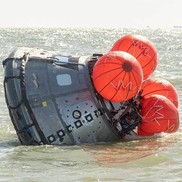|
What’s Inside: This edition of Water Wire features prize and competition updates; project selections; products and publications; WPTO project successes; STEM spotlight; and additional hot topics for the month.
Continue to follow the Water Wire and emails from WPTO for the latest news and updates from the office. Reach out to WaterPowerTechnologiesOffice@ee.doe.gov with any inquiries or suggestions.
Estimated read time: 8 minutes 30 seconds
Prize and Competition Updates

At a virtual awards ceremony this month, the U.S. Department of Energy (DOE) announced the winners of the first Marine Energy Collegiate Competition (MECC). Of the 14 collegiate teams that competed, DOE recognized the three overall winners who achieved the highest scores, as well as teams for their performance in individual categories of the competition.
The competition challenged students to create a conceptual design of a marine energy device. Participants took different approaches to meet competition criteria, proposing a range of ideas with one common goal: to power the blue economy.
Learn more about this year's competitors and what they’ve learned through the competition. If you are a student or professor interested in participating in the 2021 MECC, apply to join next year’s class of challengers.
|

On June 30, DOE launched the Innovations in Advanced Manufacturing for Hydropower (I AM Hydro) Prize, a new competition designed to leverage the power of advanced manufacturing to address some of hydropower’s most critical challenges. The I AM Hydro Prize will provide up to $250,000—split among up to 16 winners—to develop creative applications that use advanced manufacturing to lower the cost and improve the performance of hydropower components and facilities. The prize is accepting submissions until Sept. 30.
|
Back to top
Project Selections
This month, WPTO announced the selection of four projects across the country to receive Small Business Innovation Research (SBIR) and Small Business Technology Transfer (STTR) Phase II Release 2 grants, totaling nearly $4.4 million in funding.
-
Pliant Energy Systems, LLC (Brooklyn, N.Y.): This project plans to harness the kinetic energy flowing through streams and rivers to directly power a novel mechanical pump, which draws both water and energy from these flowing water sources for irrigation. If successful, this technology will be used for desalination and electricity generation.
-
Ocean Renewable Power Company (Portland, Maine): This project will use tidal energy to offset diesel fuel use on an Alaskan microgrid. Working with the City of False Pass, Alaska, Ocean Renewable Power Company will develop scalable applications of marine renewable energy as a baseload power source to eventually replace diesel generators for renewable microgrid operations.
-
Oscilla Power, Inc. (Seattle, Wash.): This project will couple a farm of innovative offshore wave energy converters (WECs) with a novel underwater energy storage system to provide reliable and high-quality utility power from wave energy. This approach will minimize electrical system costs while increasing power output consistency.
-
Resolute Marine Energy, Inc. (Boston, Mass.): This project plans to design, build, test, and validate a scaled version of a variable displacement linkage pump device for producing clean drinking water. The prototype will be integrated within a laboratory-scale desalination system and powered using a power takeoff test stand to simulate ocean waves in a series of hardware-in-the-loop, dry laboratory tests.

DOE’s Advanced Manufacturing Office recently announced the Phase 1 winners of the Water Resource Recovery Prize, a $1 million, two-phased competition that is designed to increase resource recovery from municipal wastewater treatment plants across the United States. In Phase 1, multidisciplinary teams presented their engineering schematic, business case, and technical description to support their water treatment technology concept.
The 10 winning teams from Phase 1 will move to Phase 2, where they will provide a more detailed and validated technical and financial analysis that demonstrates the sustainability of the proposed technologies. At the conclusion of Phase 2, DOE will select up to two teams to receive $250,000 in cash prizes.
Read the announcement to learn more about their winning ideas. The Water Resource Recovery Prize is part of DOE’s Water Security Grand Challenge, a framework to advance transformational technology and innovation to meet the global need for safe, secure, and affordable water.
|
Back to top
Products, Papers, and Studies
This month, WPTO released a new report—Pumped Storage Hydropower (PSH) Furthering Advancements to Shorten Time (FAST) Commissioning Technical Analysis. The report addresses both barriers and solutions to modern PSH development by establishing baseline project development knowledge, defining key aspects of project development, and identifying opportunities to reduce project timelines, costs, and risks.
The report found that, of total capital costs, civil works makes up approximately 67%, equipment approximately 26%, and engineering approximately 7%.
This product was completed as part of the HydroWIRES Initiative, which focuses on understanding, enabling, and improving hydropower and PSH contributions to reliability, resilience, and integration in the rapidly evolving U.S. electricity system.
Although tidal power technologies are not yet commercially available, they could ultimately prove valuable to our grid, as tides are a highly predictable resource. Researchers at Pacific Northwest National Laboratory (PNNL) are looking at the potential benefits tidal power offers to smooth out the peaks and valleys of electricity supplied by other renewable, but intermittent, resources like solar and wind. The study, recently published in the Journal of Marine Science and Engineering, is part of a larger project to examine how marine renewable resources could be valued for more than just their power output.
Sandia Researchers Publish Wave Energy Articles
Over the past several months, marine energy researchers at Sandia National Laboratories (Sandia) have published several articles about using resource characterization to evaluate wave energy opportunities and numerical modeling of wave field effects from single devices and arrays.
Back to top
WPTO Project Success
Tech Developers Join National Labs in Evaluating TPL Assessment Methodology
CalWave and AquaHarmonics can now be added to the growing list of technology developers that have agreed to work with Sandia and the National Renewable Energy Laboratory (NREL) to evaluate and improve the Technology Performance Level (TPL) assessment methodology. The TPL is a techno-economic performance metric for evaluating WEC technologies’ key cost and performance drivers. Developers’ feedback is critical to ensuring the usefulness of the TPL to the wave energy field.
Back to top
STEM Spotlight
Last month, in celebration of Ocean Month, DOE highlighted National Lab and WPTO team members, looking into their backgrounds, jobs, and inspiration to work in the field. These 25 individuals included scientists, researchers, engineers, and program managers who gave advice to people interested in a STEM career. Check out the spotlights on the DOE STEM Rising website to learn more about the talented professionals who support DOE’s and WPTO’s missions.
DOE recently hired five new graduate student researchers to work with DOE and partners while completing their doctoral theses focused on marine energy. Administered by WPTO and the Oak Ridge Institute for Science and Education, the new Marine and Hydrokinetic Graduate Student Research Program provides full-time doctoral students access to the expertise, resources, and capabilities available at National Laboratories and other approved facilities to conduct part of their research. The selected researchers are Jeremy Simmons II from the University of Minnesota, who will work with NREL; Brittany Lydon from the University of Washington, who will also work with NREL; and from Oregon State University, Austin Berrier, Christian Dizon, and Hannah Mankle, who will work with NREL, PNNL, and Oscilla Power (respectively). Congratulations and best of luck to these doctoral candidates!
Back to top
In Case You Missed It
Puerto Rico recently released a Request for Qualifications seeking candidates interested in leading the development of the Puerto Rico Ocean Technology Complex. The industrial and research complex will leverage ocean thermal energy conversion technology to power ocean-based industries, such as aquaculture and agriculture, and will supply the local community with desalinated water. Those interested in leading the design, development, and operation of this project must provide a statement of qualifications by Aug. 21, 2020.
|
From barges and buoys, to offshore wind and platforms to power underwater vehicles, the open-source WEC-Sim (Wave Energy Converter SIMulator) code developed by NREL and Sandia is making a splash. Learn how NASA is employing WEC-Sim to model the dynamics of their crew module in the open ocean following splash down.
|
|
 |
In late 2019, partners from Eagle Creek Renewable Energy, General Electric (GE), WPTO, and PNNL gathered to demonstrate a new set of technologies developed to improve generation and environmental performance of the recently upgraded High Rock Hydroelectric Facility. Located on the Yadkin River outside Charlotte, N.C., the partnership deployed a new type of hydropower turbine, designed by GE, which directly infuses dissolved oxygen into the water. In addition, Eagle Creek developed and installed a new proprietary linear aeration valve to inject oxygen into the river during non-generation periods. The performance of these systems was assessed using a new, mobile, dissolved oxygen monitoring system developed by PNNL and funded by WPTO. Combined, these technologies help increase dissolved oxygen in the river and enable High Rock to more effectively monitor the quality of the water near the plant.
Back to top
|